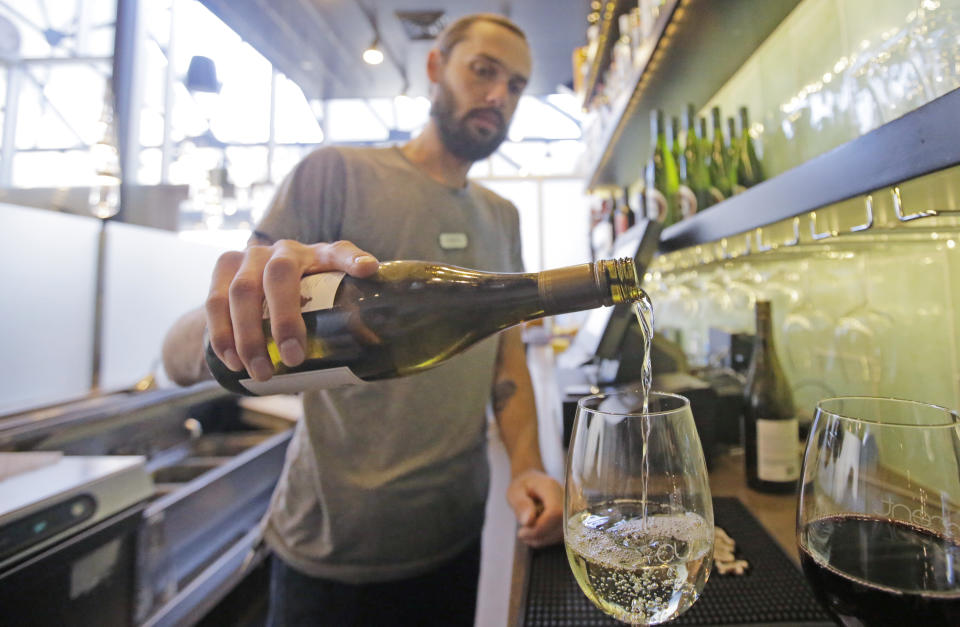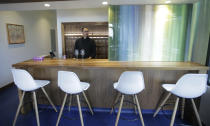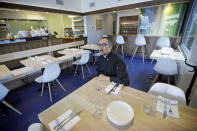New law to end hidden bartending for some Utah restaurants
SALT LAKE CITY (AP) — Some Utah restaurants are counting down the days until a new liquor law takes effect this summer, allowing them to take down walls and partitions that prevent customers from seeing their alcoholic drinks being mixed and poured.
The requirement that drinks be prepared behind a barrier, which are often glass walls or back rooms, has long been a sore spot for the hospitality industry in the heavily Mormon state.
The barriers are nicknamed Zion Curtains, a reference to the influence of The Church of Jesus Christ of Latter-day Saints, which plays an influential role in state liquor policy and teaches its members to avoid alcohol.
Proponents say the barriers discourage underage drinking by hiding the "glamour" of bartending from children. Critics say they make for strange setups in restaurants, requiring staff to walk covert drinks out to customers, who then drink them in full view of other patrons — including kids.
A law signed by the governor this week allows restaurants to take down the barriers starting July 1 if they keep those under 21 from sitting close to bars. It also requires all restaurants to make no more than 30 percent of their sales from alcohol and ensure that customers ordering drinks also order food.
Both requirements only apply to some Utah establishments now.
Here's a look at how some restaurants will adapt:
___
TAKE DOWN THE CURTAIN
At Current Fish & Oyster, a swanky downtown Salt Lake City restaurant, a frosted glass wall covering a long, glossy bar will come down at midnight July 1, said Joel LaSalle, one of the restaurant's owners.
"Not only is it ugly and covers up a beautiful bar, but it's costing us thousands of dollars in sales each month," LaSalle said.
Without the glass panels, customers could have a more pleasant experience at the bar, drinking and chatting with the bartender — who under the current setup, mixes cocktails in a glass cubicle, LaSalle said. Under the new law, LaSalle can take down the glass panels if he doesn't seat children within 10 feet of his bar.
___
BUILD A WALL OR KEEP A CURTAIN
At Salt Lake City's upscale Greek eatery Manoli's, several of the barstools at the counter leave customers staring at a colorful glass wall during their meal. Manoli Katsanevas, the chef and owner, said he'd like to take the wall down and instead reconfigure his relatively small dining room.
He doesn't have room to set up a 10-foot buffer zone like Current Fish & Oyster does, but another option under the new law lets him swap a Zion Curtain for a 5-foot, child-free zone that's fenced off by a low wall.
But Katsanevas said he doesn't know yet if state officials will measure the 5-foot zone from the area where drinks are prepared or if they will measure from the entire length of the bar. If it's the latter, he'll have to keep up his Zion Curtain.
___
RESTAURANTS BECOME BARS
East Liberty Tap House, a neighborhood pub that focuses on craft beers and classic bar food, has a certain type of Utah liquor license that doesn't require a Zion Curtain and allows them to make 40 percent of their sales from alcohol.
Owner Scott Evans said the Tap House can't meet the new law's requirement that alcohol sales don't exceed 30 percent of their business, so the restaurant will have to instead be treated like a bar. That means the restaurant will no longer be able to let minors in and will have to start electronically scanning identification at the door for anyone who looks younger than 35.
"We'll lose all the family business," Evans said.












